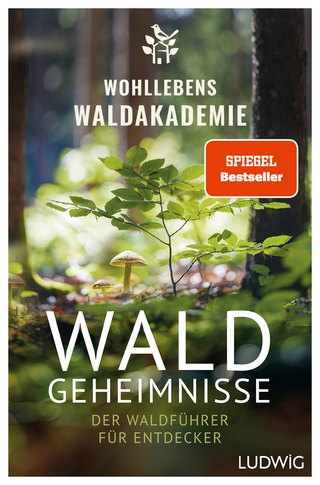
Conservation through Sustainable Use
Routledge India (Verlag)
978-1-032-38102-2 (ISBN)
The human use of nature is a polarizing topic in India and across the globe, often perceived as contradictory to traditional exclusionary conservation. However, India’s natural landscapes serve as important sources of biological resources for many communities. This collection of case studies on sustainable use practices throughout India aims to identify the policies, management strategies, and knowledge contexts that contribute to resource use without damaging biological diversity.
Through a diverse array of personal accounts, stories and photographs from the field, and ongoing research studies across biogeographic zones, readers will connect with academics, practitioners, managers, and policy analysts who challenge us to rethink the conservation paradigm. These chapters provide a reflection on the history of conservation and sustainable use in India and illuminate a path towards a local and global future in which biodiversity and human well-being go hand in hand.
The wide variety of authors in this book reflects the broad audience this book will be of interest to, from students studying environmental conservation and sustainability to researchers, practitioners, and policymakers who work in the field and seek to learn about successful sustainable use systems and resulting lessons that have widespread application. This book will appeal to readers interested in the areas of environment sciences, biodiversity management, sustainable development, developmental studies, forestry, wildlife and protected area management, public policy, environmental policy, and governance.
Anita Varghese is Director (Biodiversity) at Keystone Foundation. She holds a bachelor’s degree in Zoology (Bombay University), master’s degree in Ecology (Pondicherry University), and a doctorate in Botany (University of Hawaii). Her interests are in plant conservation specifically on sustainable use, non-timber forest products, long-term population dynamics of harvested species, invasive plants, cycads, and forest trees. Meera Anna Oommen is a trustee of Dakshin Foundation, Bangalore, and the Madras Crocodile Bank. She works on issues related to ecology, conservation science, and environmental history. Her recent work focuses on incorporating insights from multiple disciplines to understand the dynamics of human–wildlife conflict, aspects related to human–animal relationships, and the history of hunting in India. Mridula Mary Paul is a postgraduate researcher at the Department of Geography and Environmental Sciences, Northumbria University, Newcastle-upon-Tyne, UK. She has previously been Senior Policy Analyst with the Ashoka Trust for Research in Ecology and the Environment (ATREE), Bengaluru, and practised environmentallaw before the Madras High Court. Snehlata Nath is Founder Director of Keystone Foundation and has worked on conservation-livelihoods-enterprise with indigenous people in the Nilgiri Biosphere Reserve. She co-founded the NTFP Exchange Program network across Asia and has coordinated the India chapter for over 20 years.
List of Figures
List of Contributors
Foreword
Acknowledgements
1 An introduction to sustainable use: And its contribution to biodiversity conservation in India
ANITA VARGHESE, MRIDULA MARY PAUL, MEERA ANNA OOMMEN, AND SNEHLATA NATH
2 Sustainable use and biodiversity conservation: When the twain shall meet!
SNEHLATA NATH, MEERA ANNA OOMMEN, MRIDULA MARY PAUL, AND ANITA VARGHESE
PART I
Governance
3 The governance of sustainable use: Historical legacy and contemporary deployment
MRIDULA MARY PAUL
4 Small islands, big lessons: Critical insights on sustainable fisheries from India’s coral atolls
NAVEEN NAMBOOTHRI, ISHAAN KHOT, AND ABEL JOB ABRAHAM
PART II
Enterprises
5 Ensuring sustainable harvests through market-based tools and community-based organizations: A practitioner’s perspective
SNEHLATA NATH
6 Sustainable use of wild medicinal plant resources: Developing field methods for sustainable collection and direct market linkages
JAGANNATHA RAO R. AND DEEPA G.B.
PART III
Community knowledge
7 The pig and the turtle: An ecological reading of ritual and taboo in ethnographic accounts on Andamanese hunter-gatherers
MEERA ANNA OOMMEN
8 Rethinking indigenous hunting in Northeastern India: Some lessons for academics and practitioners
AMBIKA AIYADURAI AND SAYAN BANERJEE
9 Sustainable grazing practices: Conserving biodiversity in an Asian tropical grassland
PANKAJ JOSHI
PART IV
Intangible benefits
10 Counting to conserve: The role of communities and civil society in monitoring marine turtles
KARTIK SHANKER AND MURALIDHARAN MANOHARAKRISHNAN
11 Bringing reptiles into the conservation sphere: A personal account
ZAI WHITAKER
12 Linking ecotourism and biodiversity conservation: Lessons from India
KUNAL SHARMA AND LOKESH KUMAR
13 Sacred groves of Central India: Beyond the botany and the ecology
MADHU RAMNATH
PART V
Conclusion
14 Sustainable use and biodiversity conservation: Experiences, challenges, and ways forward
ANITA VARGHESE, SNEHLATA NATH, MEERA ANNA OOMMEN, AND MRIDULA MARY PAUL
Glossary
Index
| Erscheinungsdatum | 08.11.2022 |
|---|---|
| Zusatzinfo | 4 Tables, black and white; 51 Halftones, black and white; 51 Illustrations, black and white |
| Verlagsort | London |
| Sprache | englisch |
| Maße | 156 x 234 mm |
| Gewicht | 453 g |
| Themenwelt | Sachbuch/Ratgeber ► Natur / Technik ► Natur / Ökologie |
| Naturwissenschaften ► Biologie ► Botanik | |
| Naturwissenschaften ► Biologie ► Ökologie / Naturschutz | |
| Sozialwissenschaften ► Soziologie ► Spezielle Soziologien | |
| Weitere Fachgebiete ► Land- / Forstwirtschaft / Fischerei | |
| ISBN-10 | 1-032-38102-7 / 1032381027 |
| ISBN-13 | 978-1-032-38102-2 / 9781032381022 |
| Zustand | Neuware |
| Informationen gemäß Produktsicherheitsverordnung (GPSR) | |
| Haben Sie eine Frage zum Produkt? |
aus dem Bereich


